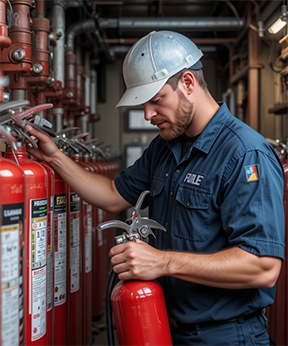Published: October 17, 2014 | Updated: September 16, 2025
Published: October 17, 2014 | Updated: September 16, 2025
Safety as the Cornerstone of Effective Maintenance Practices
 Often, discussions surrounding maintenance management and reliability gravitate towards financial gains. We examine how preventative and proactive maintenance strategies can bolster a company's financial health, focusing on cost reduction and revenue generation. While financial considerations hold importance, sometimes companies overlook a critical dimension: Safety as the cornerstone of effective maintenance practices.
Often, discussions surrounding maintenance management and reliability gravitate towards financial gains. We examine how preventative and proactive maintenance strategies can bolster a company's financial health, focusing on cost reduction and revenue generation. While financial considerations hold importance, sometimes companies overlook a critical dimension: Safety as the cornerstone of effective maintenance practices.
Integrating safety considerations into every facet of maintenance operations means more than just a regulatory requirement. You must look at it as a fundamental principle that underpins operational efficiency and long-term sustainability.
The Indispensable Role of Safety in Maintenance Operations
Whether you manage a sprawling industrial complex or oversee a critical facility, safety tops your list of day-to-day goals. You must execute certain tasks with an unwavering commitment to preventing incidents and safeguarding personnel. While keep in mind the conventional safety measures, such as ensuring structural integrity and preventing slips and falls, consider a broader perspective. A maintenance management plan that prioritizes safety can significantly enhance equipment reliability and ensure adherence to scheduled maintenance activities. This safety-centric approach transcends mere compliance; it fosters a culture of vigilance and proactive risk mitigation.
Mitigating Risks Through Proactive Maintenance
Equipment failures affect operational continuity, leading to unexpected downtime and financial losses, but they also pose significant safety hazards. Neglected equipment can precipitate accidents. Those mean potential injuries and property damage. Consider, for example, a deteriorating roof. A lack of timely repairs can lead to leaks, structural instability, and the risk of falls.
By adopting a proactive maintenance stance, you have more opportunities to spot potential hazards and address them before they escalate. This approach creates a safer work environment and contributes to the overall efficiency of maintenance operations.
Regulatory Compliance and Risk Reduction
Adopting a "safety first" mindset in maintenance practices provides a significant advantage in maintaining compliance with regulatory standards. Faulty equipment and inadequate maintenance can lead to hazardous situations, such as chemical spills and burns. The result of this neglect further risks substantial fines and penalties. By incorporating safety considerations into maintenance schedules, organizations can effectively mitigate these risks and ensure adherence to relevant regulations. This proactive approach not only protects the workforce but also safeguards the organization from legal and financial repercussions.
Let's move on to another important safety aspect that sometimes gets underestimated: Air and water quality within a facility. These factors can have far-reaching consequences, potentially leading to widespread illness and even fatalities. In environments such as moving facilities, cruise ships, hospitals, and schools, the impact of poor air or water quality can be catastrophic.
Returning to those facilities handling hazardous chemicals, they require stringent monitoring and control measures to prevent contamination and ensure the safety of all occupants. Yes, you also stay compliant by prioritizing air and water quality. This fundamental responsibility underscores an organization's commitment to safety.
Discover how streamlined maintenance processes can elevate production. Learn more.
The Crucial Role of a CMMS in a Safety-First Maintenance Strategy
A computerized maintenance management system (CMMS) plays a important role in implementing and sustaining a safety-first maintenance strategy. It acts as a central repository for all maintenance-related data, facilitating the scheduling, tracking, and documentation of safety inspections and maintenance tasks.
You create your list of assets, inventory, and preventive maintenance (PM) tasks. Within the latter, you prioritize the safety inspections, repairs, and other safety-related PMs. A quality system will give you the option of setting up routes. What are these? Let's take a brief look at these and see how they help your safety-minded program.
 Basically, routes allow for one work order that covers many areas in your facility. Example: You have ten fire extinguishers around your property. Instead of creating ten work orders for the same inspection, you create one and add the routes the worker takes to cover all of the extinguishers. This shows better efficiency, and you have documentation that all of the extinguishers received inspection.
Basically, routes allow for one work order that covers many areas in your facility. Example: You have ten fire extinguishers around your property. Instead of creating ten work orders for the same inspection, you create one and add the routes the worker takes to cover all of the extinguishers. This shows better efficiency, and you have documentation that all of the extinguishers received inspection.
A CMMS enables organizations to proactively identify and address potential hazards. This system allows for the detailed recording of safety-related maintenance, ensuring that all necessary checks and repairs are completed on schedule. Furthermore, a CMMS can generate reports and analytics that help identify patterns. From these reports, you continually refine your safety program. It also helps to track training and certifications for personnel working on specific equipment. This ensures that only qualified people are working on critical equipment.
A CMMS assists in the following ways:
- Scheduling and tracking safety inspections: Ensuring regular checks of safety equipment and critical infrastructure.
- Documenting maintenance activities: Maintaining detailed records of repairs and inspections for compliance and analysis.
- Generating reports and analytics: Identifying trends and patterns to improve safety performance.
- Managing work orders: Prioritizing safety-related tasks and ensuring timely completion.
- Inventory management: Maintaining an adequate supply of safety-related spare parts and equipment.
By properly using the capabilities of a CMMS, organizations can create a more organized and efficient maintenance operation, enhancing safety and reducing the likelihood of incidents.
When presenting maintenance plans to employees, emphasize the safety implications. Highlighting how a safety-first approach prevents equipment failures, minimizes financial losses, and most importantly, protects human lives underscores the value of a comprehensive maintenance strategy. Placing safety at the forefront of maintenance discussions demonstrates a commitment to responsible operations and fosters a culture of care and accountability.
In the pursuit of operational excellence, we must recognize the link between safety and maintenance. A well-executed maintenance strategy, grounded in safety principles, not only preserves assets and ensures compliance but also safeguards the well-being of all employees and visitors. By prioritizing safety, organizations can create a resilient and sustainable operational framework that benefits everyone involved.
FAQs
Why is safety important in maintenance management?
Safety ensures the protection of workers, reduces risks of accidents, and creates a more reliable and efficient maintenance operation.
How does proactive maintenance improve workplace safety?
Proactive maintenance identifies hazards early, prevents equipment failures, and reduces the risk of accidents and downtime.
What role does regulatory compliance play in facility safety?
Compliance with safety regulations helps avoid fines, protects employees, and ensures organizations meet legal and environmental standards.
How can air and water quality affect maintenance safety?
Poor air or water quality can cause illness, contamination, and safety risks, especially in facilities like hospitals, schools, and industrial plants.
How does MAPCON CMMS support safety in maintenance practices?
MAPCON CMMS helps schedule inspections, track safety tasks, manage inventory, and document compliance, ensuring hazards are addressed on time and properly recorded.
What safety-related features should you look for in a CMMS?
MAPCON CMMS offers preventive maintenance scheduling, safety routes, inspection tracking, reporting, and certification management for staff to ensure safe and efficient operations.
MAPCON | 800-922-4336
MAPCON CMMS software empowers you to plan and execute PM tasks flawlessly, thanks to its wealth of features and customizable options. Want to see it for yourself? Click the button below to get your FREE 30-day trial of MAPCON!
Try It FREE!